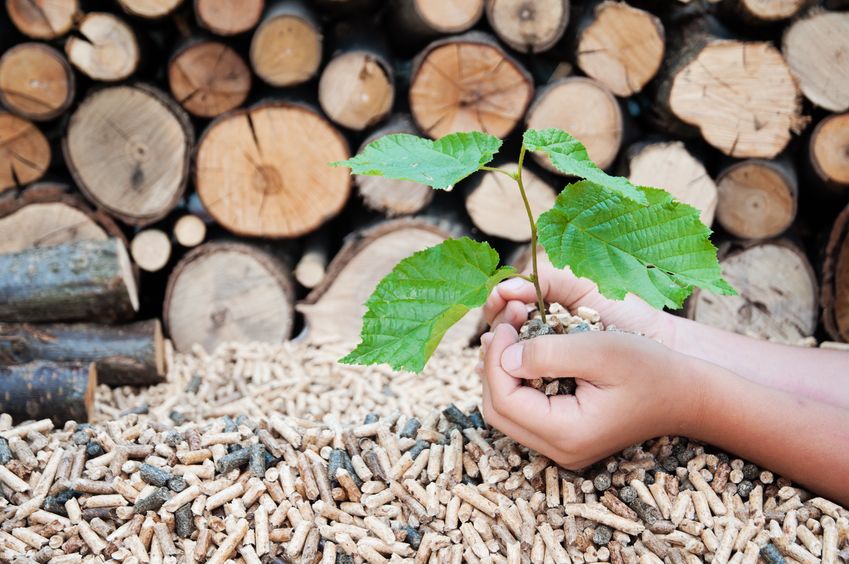One of the major “burning issues” of the day is whether burning wood as biomass is green – or at least green enough. The European Union has classified biomass as a carbon-neutral source of heat and electricity, and the U.S. government has endorsed its widespread use as a “clean” fuel whose use also helps reduce destruction from forest fires. But not everyone agrees.
The U.S. Energy Information Administration (EIA) defines biomass as organic material that comes from plants and animals that is a renewable source of energy. Wood and wood processing wastes are used to heat buildings, produce process heat in industry, and generate electricity.
Biomass fuels provided about 5% of total primary energy use in the United States in 2017. Of that 5%, about 47% was from biofuels (mainly ethanol), 44% was from wood and wood-derived biomass, and 10% was from municipal waste.
Much of the U.S. production of wood pellets is shipped to Europe to displace coal as a power plant fuel. Under terms of the Paris Climate Accord, wood pellets and other biomass fuels have been declared carbon neutral. Overall, in 2018, the 28 European Union nations consumed 26.1 million metric tons of wood pellets, with U.S. exports accouting for about 7 million tons.
The Trump Administration has been a strong supporter of energy production from woody biomass. Speaking to a group of foresters in Georgia in 2018, then-EPA Administrator Scott Pruitt touted forest biomass as carbon neutral and stated that:
The use of biomass from managed forests can bolster domestic energy production, provide jobs to rural communities, and promote environmental stewardship by improving soil and water quality, reducing wildfire risk, and helping to ensure our forests continue to remove carbon from the atmosphere.
President Trump has also been a vocal critic of California (and prior federal) forest policies that discourage the harvesting of excess wood, citing this policy as a chief cause for the massive destruction caused by forest fires in that state.
A December 2018, Trump Executive Order requires forest management plans to include the encouraging, harvesting and export of biomass and biochar. The Order also directs the Interior and Agriculture Departments to incentivize the expansion of markets and uses of forest products resulting from restoration and fuel reduction projects.
But the U.S. Senate in 2017 failed to approve the House-passed, bipartisan “Resilient Forests Act” sponsored by Rep. Bruce Westerman (R, AR), the only certified forester in the Congress. Westerman stated that California alone has 129 million dead trees spread across 8.9 million acres that might be harvested, but state policies have made such harvesting illegal or unprofitable.
Westerman also noted that, in Arkansas, “We’re producing 16 million more tons of wood every year than what we’re consuming. And that’s happening all across the South. We have a wall of wood and an oversupply of timber, which compounds the problem.
Up in New England, though, green opposition is helping to drive woody biomass plants out of business. Dartmouth University recently canceled plans to construct a wood-chip power plant after students protested it would not be carbon neutral. Dartmouth sustainability director Rosi Kerr explained, “Let’s really understand how burning wood from the forest for heat is going to impact climate change.” In addition, assaults on the logging industry have brought about the shuttering of several small wood-chip burning power plants in New Hampshire that have been in operation since the 1980s.
Worldwide, the fight against woody biomass is escalating. Friends of the Earth Scotland claims that “big biomass” violates the human rights of forest communities and (of course) contributes to “climate change” by encouraging deforestation, land grabs by big corporations, monoculture plantations, and abuse of indigenous rights.
Gerard Reid and Gerard Wynn, writing in https://energyandcarbon.com, challenge the concept that biomass is even carbon neutral (the qualifier for “renewables”). They cite a Chatham House (U.K.) study that suggests using wood biomass for energy purposes could actually release higher levels of emissions than emissions from burning coal or natural gas. Chatham House faulted international greenhouse gas accounting rules that place biomass emissions in the land-use sector instead of the energy sector.
The website www.alternativeenergygeek.com insists that cutting down forests to use wood as a biomass fuel creates a double negative for the environment; trees capture and hold carbon, while burning them releases high levels of carbon dioxide. These nitpickers also cite flooding and erosion and emissions resulting from truck and rail shipments as biomass negatives. [No such accounting is done, of course, for wind and solar projects.]
But should “carbon neutrality” even be the primary consideration in choosing woody biomass as a fuel? And for that matter, should we not calculate the increased emissions from preventable forest fires in determining the net impact of harvesting wood for energy?
